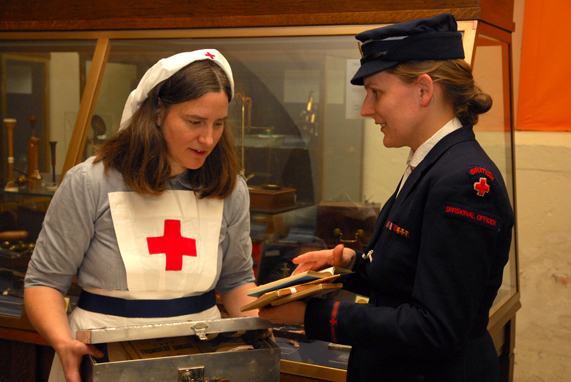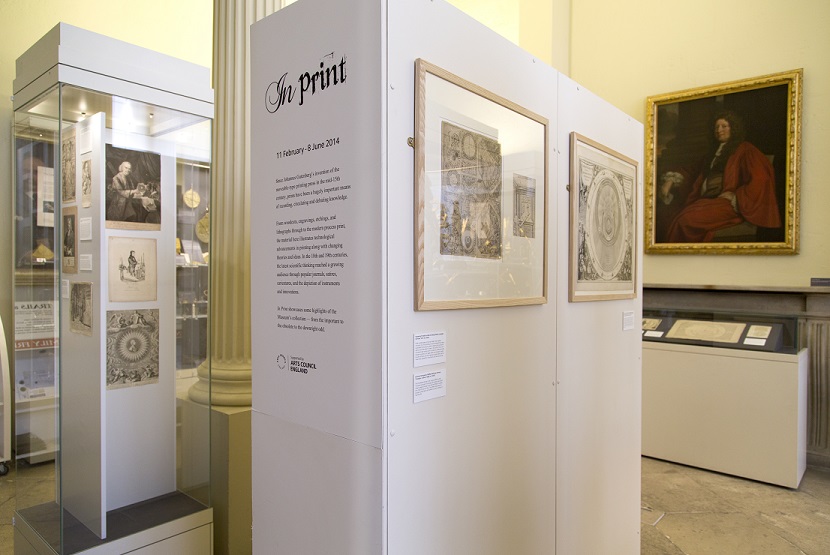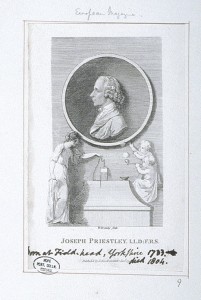By Michelle Holloway, Education Officer

Michelle and a colleague model the Indoor and Outdoor nurse unifoms from the new handling collection
I was very excited when I heard that we had the opportunity to acquire some new objects from the Balfour Museum at the British Red Cross Offices in Winchester, which are to be closed down and the Museum with them. I had been looking for ways to build a Primary school session around our penicillin collection, and the possibility of acquiring some handling objects seemed an ideal way to shape a session, as well as adding to the existing session for secondary schools about the development of Penicillin. The WW2 connection is a great context for the climax of the story of penicillin. Handling objects are useful anyway, for any number of reasons, and education departments are always keen to acquire them, particularly when they are being offered free of charge.
At the end of December 2012, our long list of requested objects was de-accessioned from the Balfour, and found its way to the University of Oxford Joint Museum Education Service. While we will share all the objects (in fact, there is often lending and borrowing between the education departments of all the University Museums), a selection have found their way here, to serve as inspiration and motivation for the creation and promotion of a WWII session for primary schools.
We have been lucky enough to acquire two full indoor and outdoor uniforms, and when one of each came out of the box in the office, how could we resist trying them on? The result can be seen in the photograph above.
The process of acquiring the objects began in October 2012, when I went with a colleague from the Oxford University Joint Museums Service to the Balfour Museum where we found a small room packed with a huge assortment of objects and uniforms, mostly from the period around the Second World War. Armed with a list of the items on offer we viewed a table full of objects selected by the Balfour Collections Manager.
The room was very quiet and we were shy to reveal how many of these objects we would love to have, but just as we were in whispered conversation about how many would seem too greedy, the kind Collections manager piped up from the corner with “Everything here has to go, so please feel free to take anything that you might like”. It then became a question of reigning ourselves in, and remembering how we were hoping to use the objects for education.
While it was exciting to be choosing objects to take away with us, the rows of uniforms hanging in translucent dry cleaning bags, booklets on topics from first aid to how to deal with gas attacks, bandages, feeding cups, bedpans, first aid kits and myriad other miscellaneous objects hit me with a poignancy that I had not expected.
It was the drawers full of hundreds of medals for service (sometimes engraved with the names of the individuals who had earned them) which particularly struck me. Each of these represents an individual, most likely a woman, and also likely very young, who had no idea of the outcome of the war, nor how long it would ultimately last, nor what post-war England would bring in terms of rationing and hardship.
In a small, blue “British Red Cross Society First Aid Manual No. 1”, inscribed in pencil on the overleaf with “H.G.Rutherford, spring 1939”, I discovered a clipping from a newspaper:
Sniff and Snatch it?
Yes, I mean a gas mask. A hundred letters a day and they all ask me how they’ll know the kind of gas. Here’s a reader’s way.
’Ware Gas!
If you get a choking feeling
And a smell of musty hay,
You can bet your bottom dollar
That there’s PHOSGENE on the way.
But the smell of bleaching powder
Will inevitably mean
That the enemy you’re meeting
Is the gas that’s named CHLORINE.
When your eye begins a-twitching
And for tears you cannot see,
’Tisn’t mother peeling onions
But a dose of C.A.P.
If the smell resembles pear-drops,
Then you’d better not delay,
It’s not the youngster sucking toffee,
But that tear gas K.S.K.
Should you sniff a pungent odour
As you’re going home to tea,
You can safely put your shirt on it
They’re using B.B.C.
If you see an oily liquid
On the road – be on your guard;
It isn’t where a bus was parked,
But that wicked gas MUSTARD.
Peaceful geraniums may
Look pleasant in a bed.
Dodge their scent in wartime;
It’s LEWISITE! You’re dead!
Thank you, Mr. Staniforth, of Nottingham
And grateful thanks must go to the Balfour Museum for their generosity in donating these exciting new objects to our handling collection, and for delivering them to us here in Oxford.







